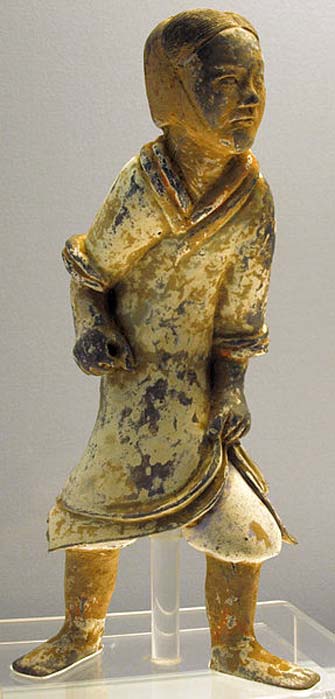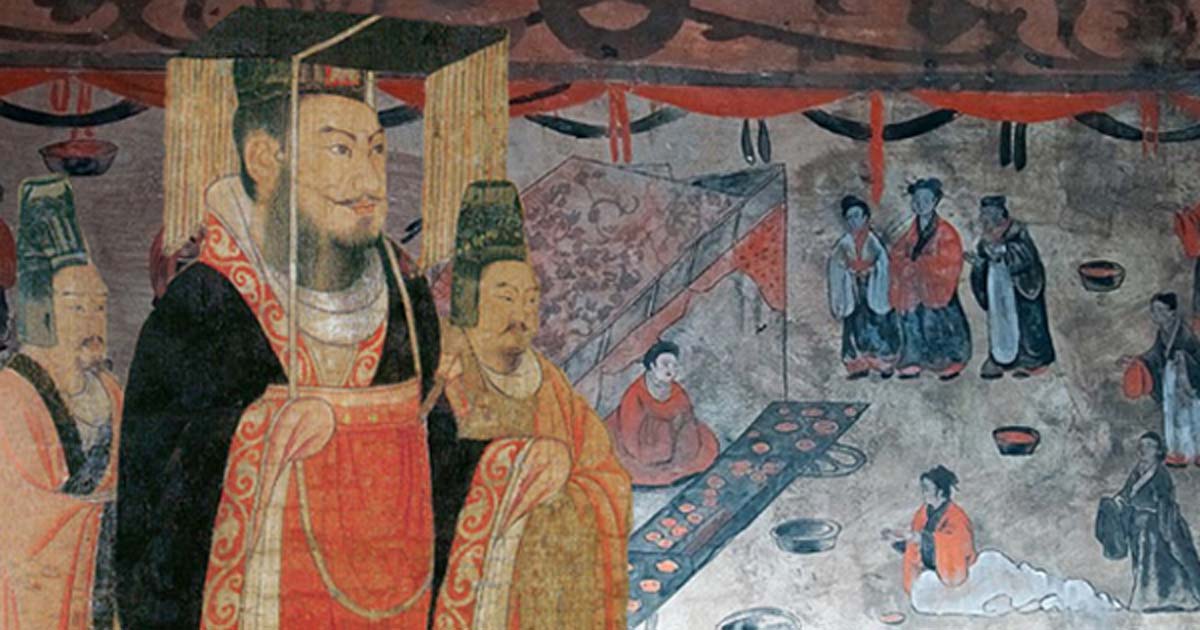Part II: The End Comes Slowly - The Last Han Dynasty Emperors
Wang Mang’s usurpation of the throne and the establishment of the Xin Dynasty brought the Han Dynasty to a temporary end. Displeasure with the Xin Dynasty, however, caused rebellions to break out all over the country, and in 23 AD, Wang Mang was overthrown and killed. One of the rebel leaders, Liu Xuan, a member of a distant branch of the Han imperial clan, was proclaimed emperor. The Han Dynasty was back.

Han Dynasty pottery palace created for elite burial, c. 2nd century BC - 2nd century AD, Henan Provincial Museum, Zhengzhou, China. (Gary Lee Todd/CC BY SA 4.0)
Liu Xuan took the title of Emperor Gengshi of Han, and his ascension to the throne has sometimes been regarded as the restoration of the Han Dynasty. The new emperor, however, was weak and incompetent, and in 25 AD, he was overthrown and strangled to death by the Chimei (which literally means ‘Red Eyebrows’) rebels. A puppet emperor, a teenager by the name of Liu Penzi, was placed on the throne by the rebels.

A mural showing chariots and cavalry, from the Dahuting Tomb of the late Eastern Han Dynasty (25-220 AD), located in Zhengzhou, Henan province, China. (Public Domain)
The Eastern Han
At the same time, another descendant of the Han imperial clan, Liu Xiu (known also by his posthumous name as Emperor Guangwu of Han), seized the opportunity to claim the imperial throne. Liu Xiu had already proven himself to be a brilliant strategist on the battlefield when he defeated a numerically superior Xin army at the Battle of Kunyang in 23 AD.
- Taking Beauty to New Heights in China: What Stunning Sights Emerge on Huangshan and its Bridge of Immortals?
- Chinese civilization may have begun 2,400 years earlier than previously thought
- Han Purple: A 2,800-year-old artificial pigment that quantum physicists are trying to understand
This was proven once more when he fought against the Chimei rebels. When the rebels were defeated, Liu Penzi was removed from the throne, and Liu Xiu became the new emperor. Traditionally, Emperor Guangwu, rather than Emperor Gengshi, is regarded to be the first emperor of the restored Han Dynasty, which is known also as the Later or Eastern Han.

Emperor Guangwu as depicted in "The Ming Dynasty Encyclopedia" (Sancai tuhui). (Public Domain)
Emperor Guangwu and His Descendants Create Another Golden Age
Although Liu Xiu became the Emperor of China, he was not yet the undisputed ruler of the country. During the chaotic years that preceded his ascension to the throne, regional warlords had risen across the country, and it would take Emperor Guangwu about a decade to reunify China.
The emperor favored peaceful means to assert his authority over these regional warlords, and the use of force was often taken as a last resort. Emperor Guangwu’s benevolent nature may also be seen in the way he dealt with the Chimei leaders who surrendered to him after their defeat. Instead of executing them, he spared their lives. This clemency was extended even to the puppet emperor, Liu Penzi.
The next two emperors of the Eastern Han were Emperor Ming of Han and Emperor Zhang of Han, the former being the son, and the latter the grandson, of Emperor Guangwu. The combined reign of these emperors is remembered by later generations as the golden age of the Eastern Han and it was a time of peace and prosperity.

Detail of a mural from an Eastern Han tomb at Zhucun, Henan province. The two figures in the foreground are playing Liubo, with the playing mat between them, and the Liubo board to the side of the mat. (Public Domain)
As an example, during this period, Chinese control over the Tarim Basin was secured, thanks to the campaigns of the general Ban Chao against the nomadic Xiongnu. This is significant, as it gave the Eastern Han access to the Silk Road, which not only facilitated the exchange of goods, but also of culture.

A foreigner depicted as a camel driver; Chinese terracotta sculpture from the Northern Wei Dynasty (386-534 AD). Cernuschi Museum, Paris, France. (Guillaume Jacquet/CC BY SA 3.0)
The Han Dynasty Declines a Second Time
Following Emperor Zhang’s death in 88 AD, the Eastern Han began its gradual decline. One of the main factors contributing to this is the fact that the throne was occupied by a series of emperors who were minors. This resulted in the rise of three powerful factions in the imperial court – the eunuchs, the clans of the empresses, and the Confucian scholar-bureaucrats, each vying for control of the emperor and the empire.
Whilst infighting was going on at the upper levels of Chinese society, it was the peasants who were suffering the most. To make matters worse, the country was struck by numerous natural disasters, such as earthquakes, plagues, and floods. The court was unable to, or unconcerned with, providing aid to the peasants. The natural disasters were considered by some to be a sign of Heaven’s wrath.

Carved reliefs on stone tomb doors showing men dressed in Hanfu, with one holding a shield (Public Domain), the other a broom (Public Domain), Eastern Han Dynasty (25–220 AD), from Lanjia Yard, Pi County, Sichuan province, Sichuan Provincial Museum of Chengdu.
The Yellow Turban Rebellion
In 184 AD, a major peasant uprising known as the Yellow Turban Rebellion broke out across the empire. Inspired by Taoist teachings, the rebels believed that the emperor had lost the Mandate of Heaven, and therefore was no longer fit to rule. Although the main rebellion was crushed in 185 AD, pockets of resistance remained, and smaller rebellions broke out across China in subsequent years. The revolt would only be fully suppressed in 205 AD.
- Victory Over the Hun: Famous Lost Account of Han Dynasty Triumph Found Carved onto Mongolian Mountain
- The Leshan Giant Buddha: Largest Stone Buddha in the World
- Archaeologists announce rare discovery of more than 100 Han Dynasty tombs in China

A Han Dynasty era pottery soldier, with a now-faded coating of paint, is missing a weapon. (Captmondo/CC BY SA 3.0)
Although the Eastern Han succeeded in defeating the Yellow Turban rebels, it was at a high cost, and the dynasty continued to decline. Imperial authority soon collapsed and regional warlords emerged. This marks the prelude to the period of Chinese history known as the Three Kingdoms. The Eastern Han would linger on until 220 AD, when its last emperor, Emperor Xian of Han, was forced to abdicate by Cao Pi, the King of Wei.

Emperor Xian of Han with Consort Dǒng (left) and Empress Fú Shòu (right). (Public Domain)
Top Image: Liu Xiu, Emperor Guangwu of Han, Liu Heng, Emperor Wen of Han, or Cao Pi, King of Wei. (Public Domain) Background: Dahuting tomb banquet scene, mural detail, Eastern Han Dynasty. (Public Domain)
By Wu Mingren
References
History.com Staff, 2017. Han Dynasty. [Online]
Available at: https://www.history.com/topics/han-dynasty
New World Encyclopedia, 2014. Han Dynasty. [Online]
Available at: http://www.newworldencyclopedia.org/entry/Han_Dynasty
The Editors of Encyclopaedia Britannica, 2017. Han Dynasty. [Online]
Available at: https://www.britannica.com/topic/Han-dynasty
The Metropolitan Museum of Art, 2000. Han Dynasty (206 B.C.–220 A.D.). [Online]
Available at: https://www.metmuseum.org/toah/hd/hand/hd_hand.htm
Theobald, U., 2011. Emperor Han Guangwudi 漢光武帝 Liu Xiu 劉秀. [Online]
Available at: http://www.chinaknowledge.de/History/Han/personshanguangwudi.html
Wu, D., 2013. Liu Xiu: Decisive Emperor of Great Mercy. [Online]
Available at: https://www.theepochtimes.com/liu-xiu-decisive-emperor-of-great-mercy_133827.html



















